This Seafood Jambalaya with Shrimp also includes lump crab meat and can be prepared Cajun or Creole style. This dish combines succulent seafood infused with aromatic spices and Holy Trinity vegetables for an explosion of flavor. Get ready to savor every bite of this mouthwatering delight that captures the essence of Louisiana cuisine.
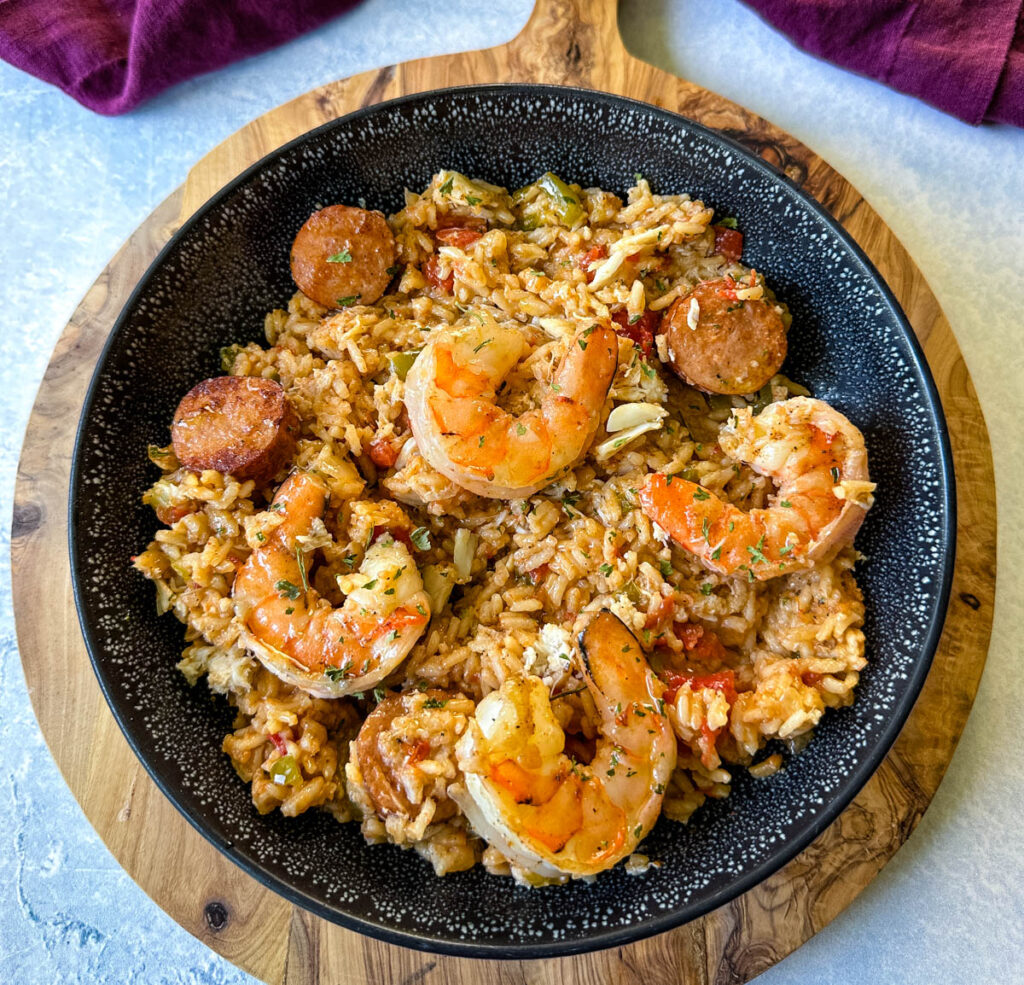
This post contains affiliate links. Please read my full disclosure here.
What is Jambalaya
It’s a flavorful and hearty dish that originates from Louisiana, particularly the Creole and Cajun cuisines. It’s a one-pot meal that consists of rice cooked with a combination of meats (such as sausage, chicken, or seafood), vegetables, and a medley of traditional spices. In our family, seafood goes in jambalaya and things like beef and chicken go in dirty rice. It will vary widely depending on who you ask!
There are two main variations of jambalaya:
- Creole Jambalaya: This style of jambalaya is associated with the city of New Orleans and tends to include tomatoes, which give the dish a reddish color.
- Cajun Jambalaya: The Cajun version of jambalaya, typically comes from rural areas of Louisiana and usually does not contain tomatoes.
Jambalaya is a beloved staple of Louisiana cuisine and is often enjoyed during festive occasions, gatherings, and celebrations.
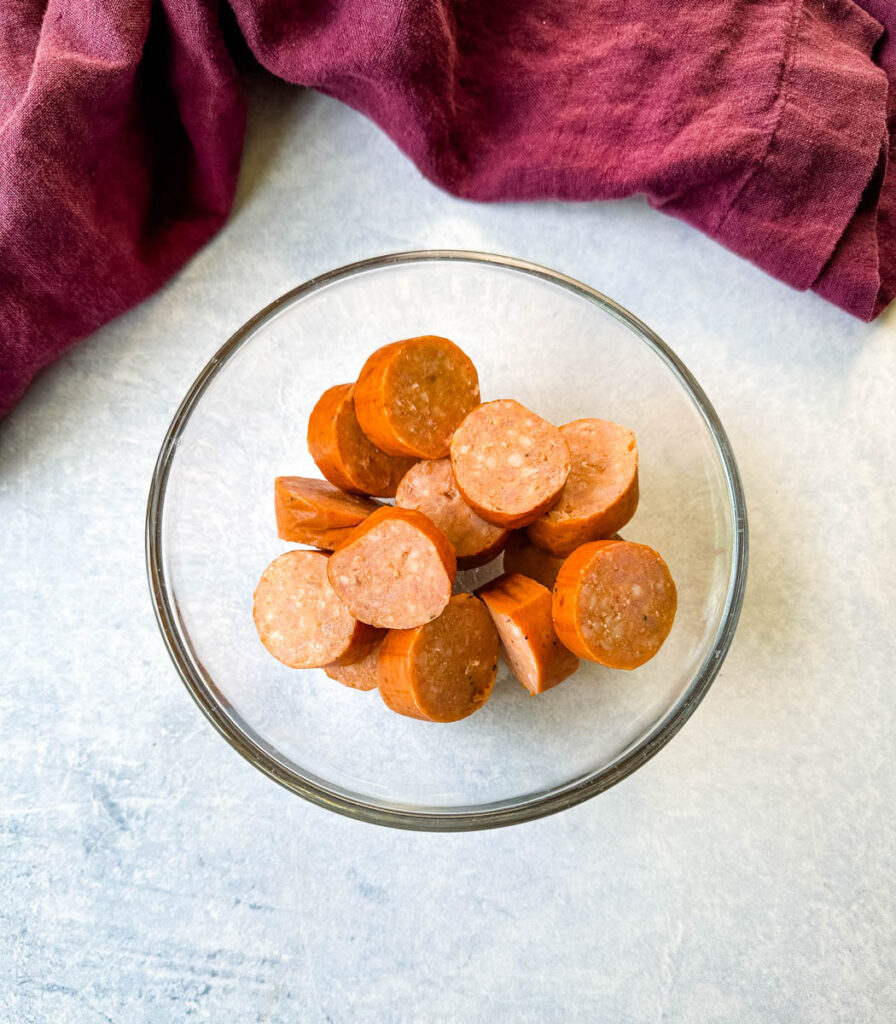
What Type of Seafood to Use
You can use whatever type of seafood you like. Just be sure to cook it separately from the rice. Seafood cooks fast. You don’t want to cook it for longer than a few minutes or it will become rubbery and tough. I add shrimp and lump crab meat. Here are some options:
- Shrimp: Shrimp is a classic choice. It cooks relatively quickly and absorbs the flavorful spices and broth of the dish.
- Crawfish: Crawfish is a popular seafood in Louisiana cuisine. Its tender and delicate texture makes it a great addition to jambalaya. If using whole crawfish, make sure they’re properly cleaned before adding them to the dish.
- Crab: Lump crab meat, whether from crab claws or crab legs, can add a luxurious and sweet flavor.
- Oysters: These will add a unique briny flavor.
- Fish: Firm fish fillets such as catfish, snapper, or grouper can also be used.
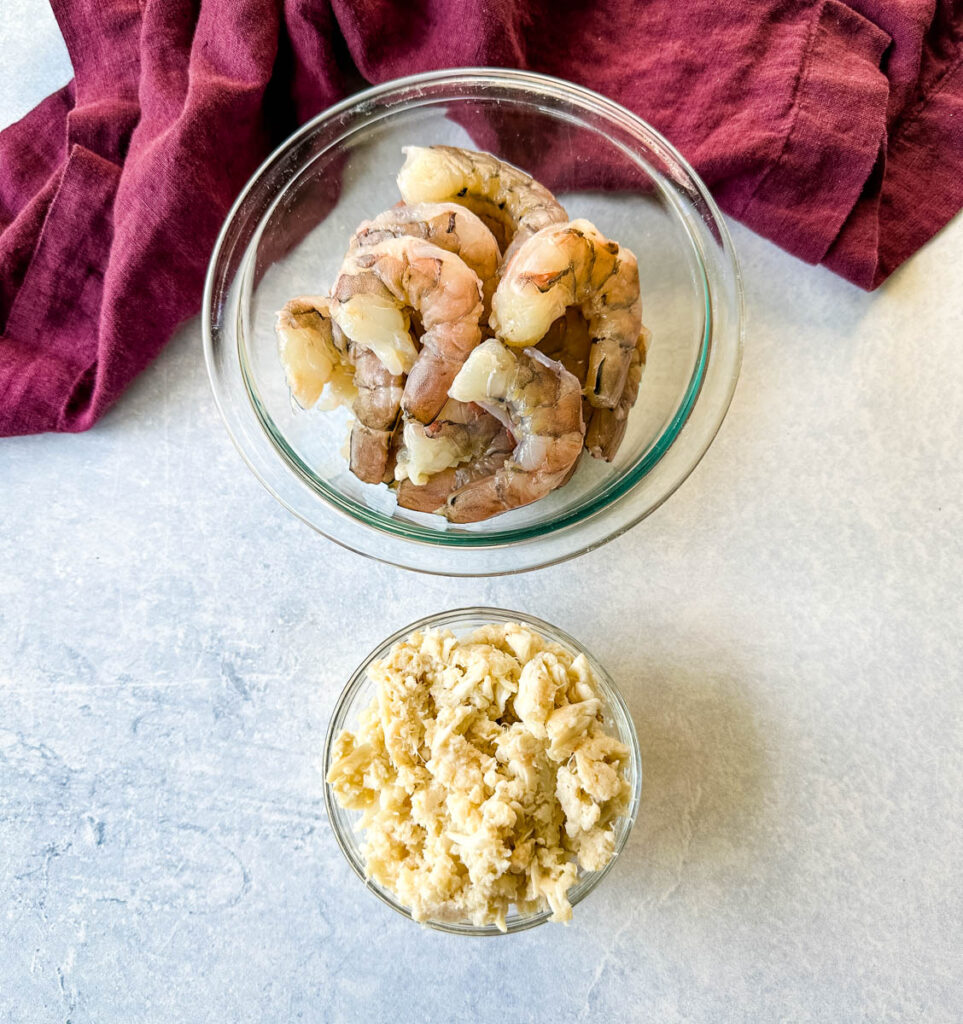
What Type of Shrimp to Use
- Size: I’m a jumbo shrimp lover, but, medium-sized shrimp are often preferred for jambalaya. They are typically labeled as “21-25 count” or “31-35 count,” which means there are approximately 21 to 25 or 31 to 35 shrimp per pound. These sizes are ideal because they are easier to eat in a single bite. Pick what you prefer and check out our Shrimp Size and Count Per Pound Guide.
- Peeling and Deveining: For convenience, consider using peeled and deveined shrimp. This will save you time and effort during preparation.
- Fresh vs. Frozen: If you have access to fresh, high-quality shrimp, that’s the best option. However, frozen shrimp can work well too, especially if they are frozen shortly after being caught to preserve their quality. Thaw frozen shrimp before using them in the recipe.
- Tail-On or Tail-Off: The choice of whether to leave the tails on or off is largely a matter of personal preference. Leaving the tails on can enhance the presentation of the dish, but removing them will make eating more convenient.
What Type of Rice to Use
Traditionally, long-grain white rice is used. This type of rice helps prevent the dish from becoming overly mushy, which is essential for achieving the characteristic texture of a well-made jambalaya.
Other types of rice like short-grain white rice or brown rice can also be used, but they will require different cooking times and adjustments to the liquid ratio in the recipe.
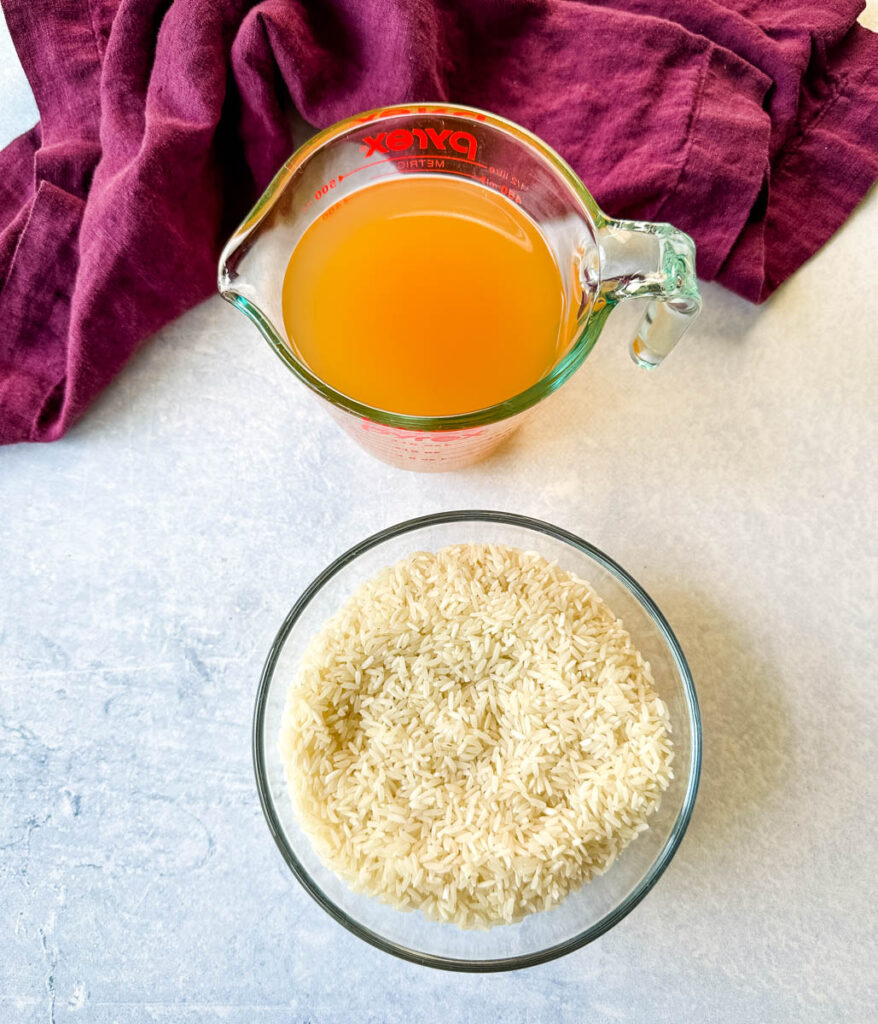
Holy Trinity Vegetables
The “Holy Trinity” is a term used in Cajun and Creole cooking and includes three ingredients: onions, bell peppers, and celery. These are considered the foundation of many dishes and are used to create a flavorful base for gumbo, jambalaya, dirty rice, grits, and more.
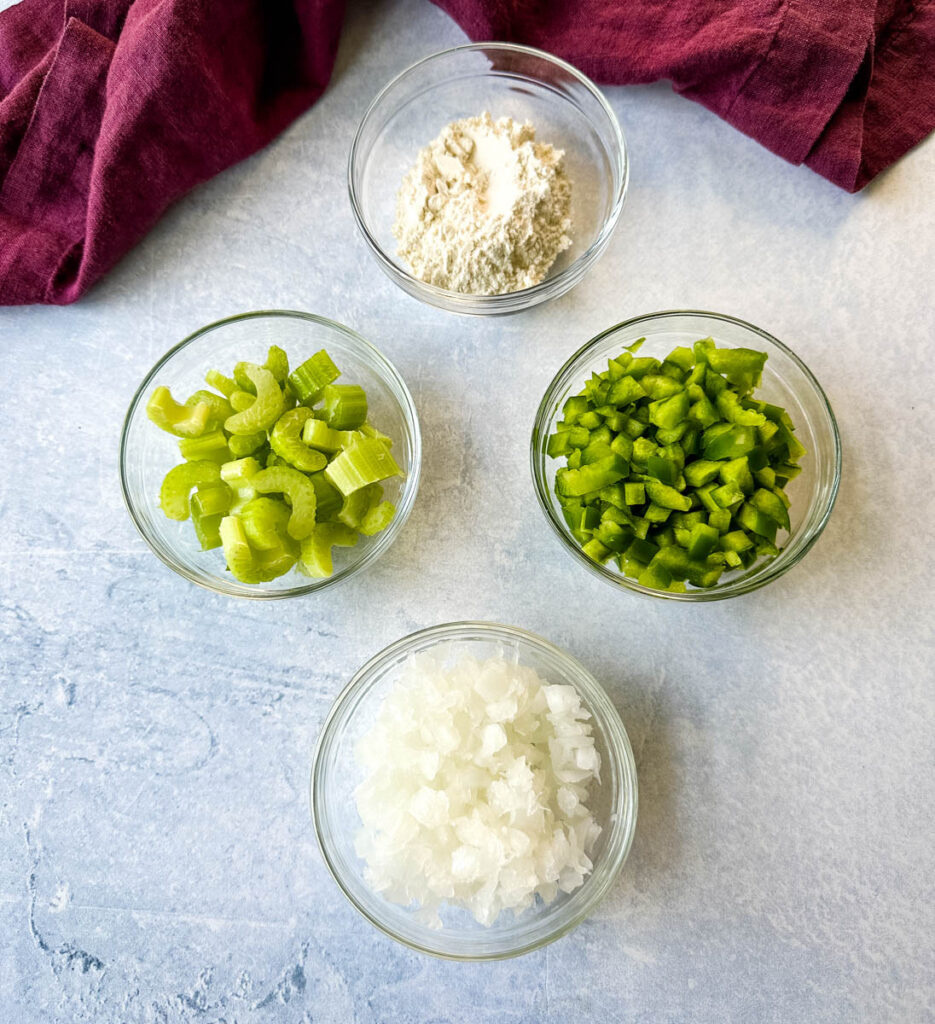
Spices and Seasoning
The recipe utilizes Creole Seasoning and smoked paprika. Creole Seasoning is known for it’s bold aromatic flavor and includes spices like thyme, oregano, garlic powder, onion powder, black pepper, and celery seed. It isn’t spicy, in comparison to Cajun seasoning.
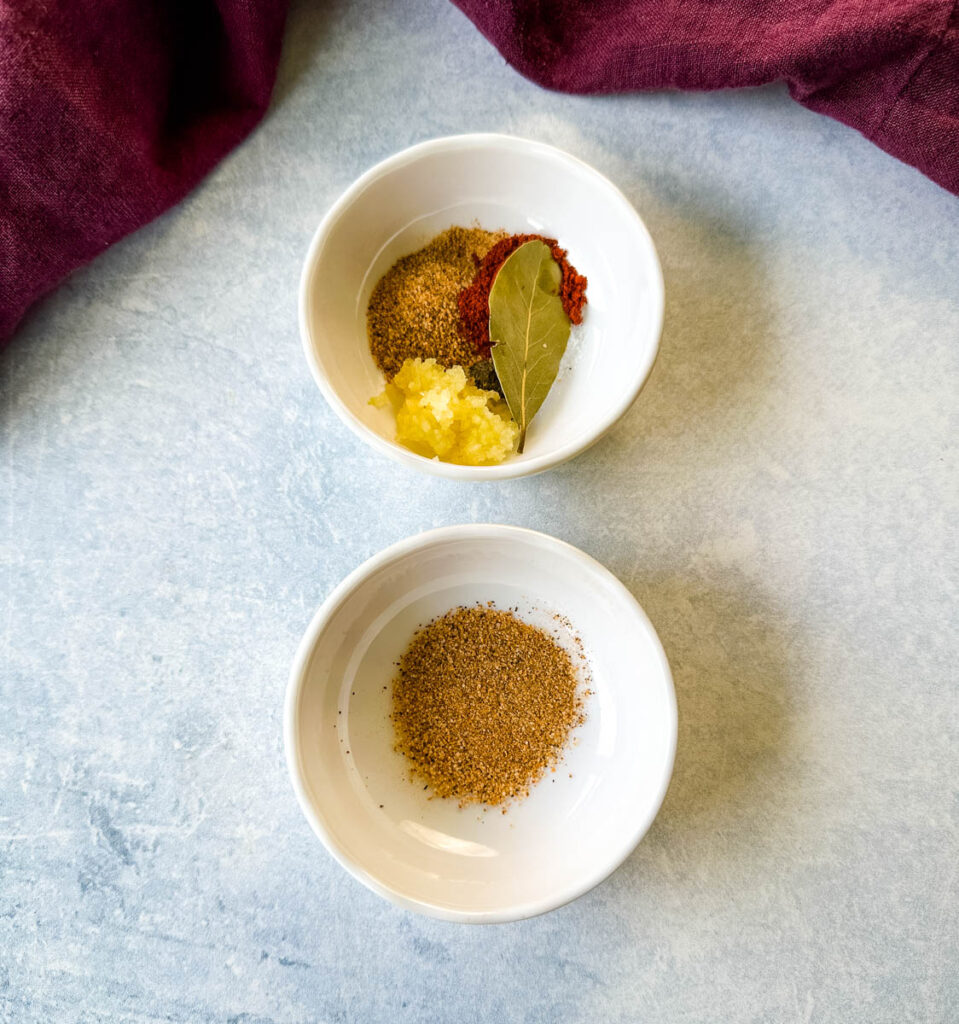
Tomatoes
The use of tomatoes is a common debate and it really just depends on if you want a Creole or Cajun dish. Creole dishes are usually made with tomatoes. If you don’t want to add tomatoes, then don’t. It will not alter the preparation or cooking time of the dish.
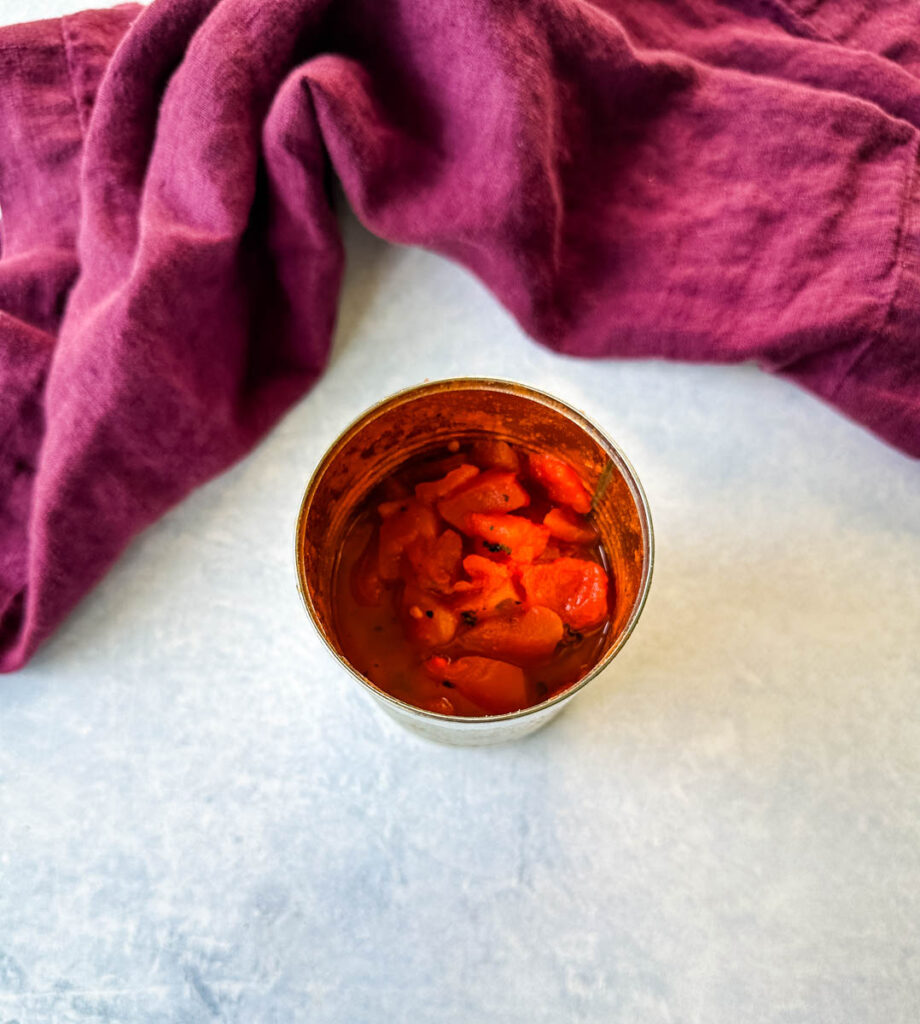
How to Make Seafood Jambalaya with Shrimp
Full detailed instructions are below in the recipe card.
- Season the shrimp.
- Add olive oil to a pan on medium heat with the seasoned shrimp and cook.
- Remove the shrimp from the pan and set aside. Add the sausage to the pan.
- Cook the sausage. Remove the cooked sausage and set it aside.
- Add in garlic, green peppers, onions and celery. Stir and cook until the onions and garlic are fragrant.
- Add in flour and diced tomatoes. Stir until the mixture is fully coated with flour.
- Add in rice and stir to toast the rice with the flavors of the pan.
- Pour in the broth and add the broth and cooked sausage to the pan.
- Adjust the heat to boiling and add a bay leaf, Creole Seasoning, salt and pepper to taste, and smoked paprika.
- Once the pot reaches a boil, reduce the heat on the stove to low. Cover the pan and simmer.
- Add the shrimp and crab to the rice.
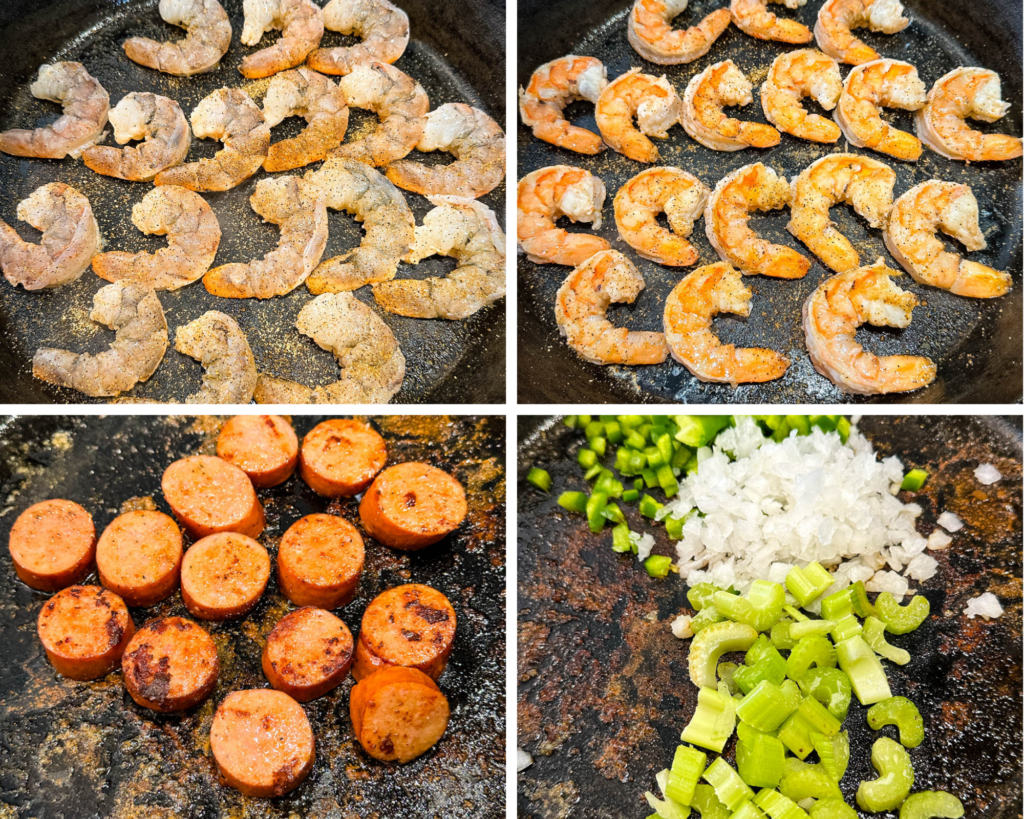
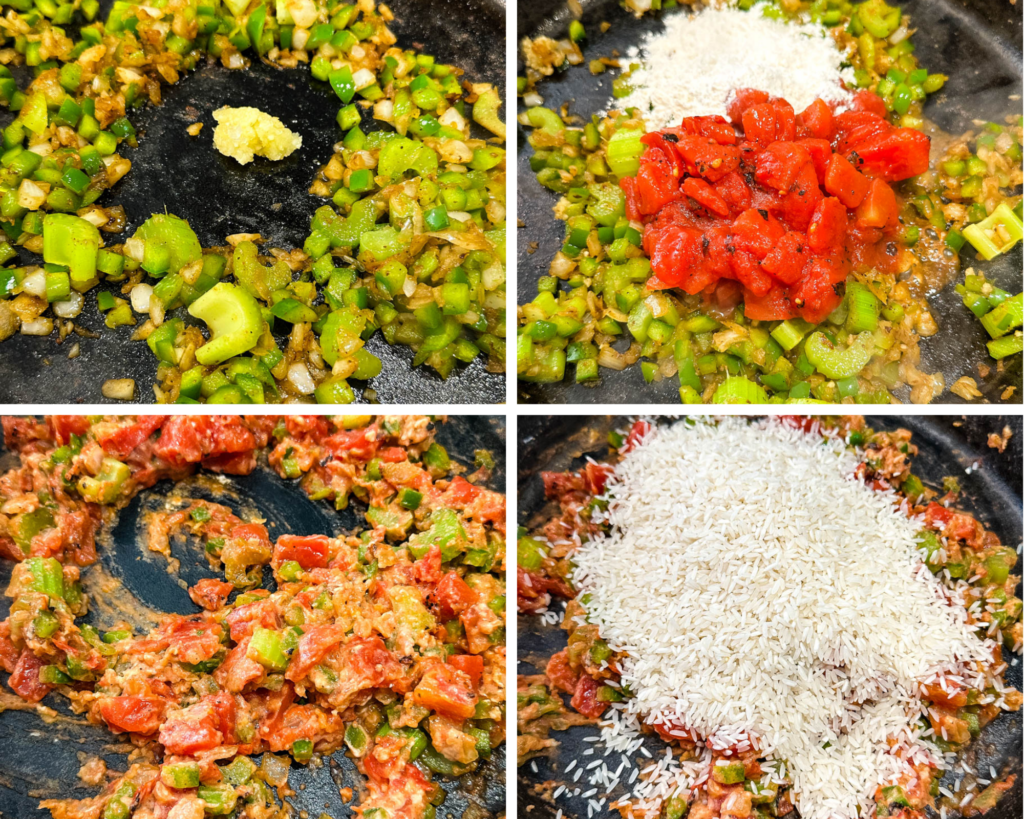
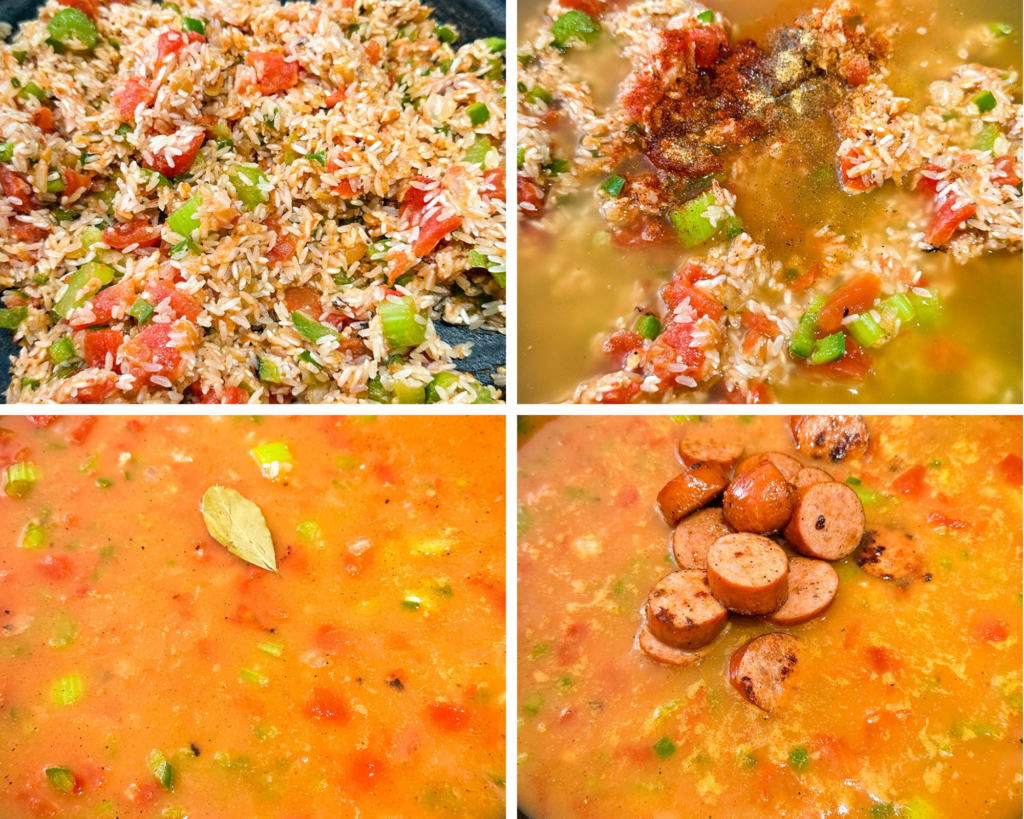
What Type of Pan to Use
You’ll want to use a pan or skillet that provides even heat distribution and allows you to easily sauté the vegetables and add the broth without overcrowding. Here are some options:
- Cast Iron Skillet: Cast iron skillets are known for their excellent heat retention and even heating. They can create a beautiful caramelization on the apples due to their ability to hold and distribute heat effectively. I use a 12 inch for this recipe.
- Stainless Steel Skillet: Stainless steel skillets also offer even heating and are durable. They are less nonstick than other options, so you might need to use a bit more oil or butter to prevent sticking.
- Dutch Oven: Dutch ovens are known for their size and excellent heat retention and distribution.
- Sauté Pan: A sauté pan has straight sides and a larger cooking surface, making it suitable for cooking large batches.
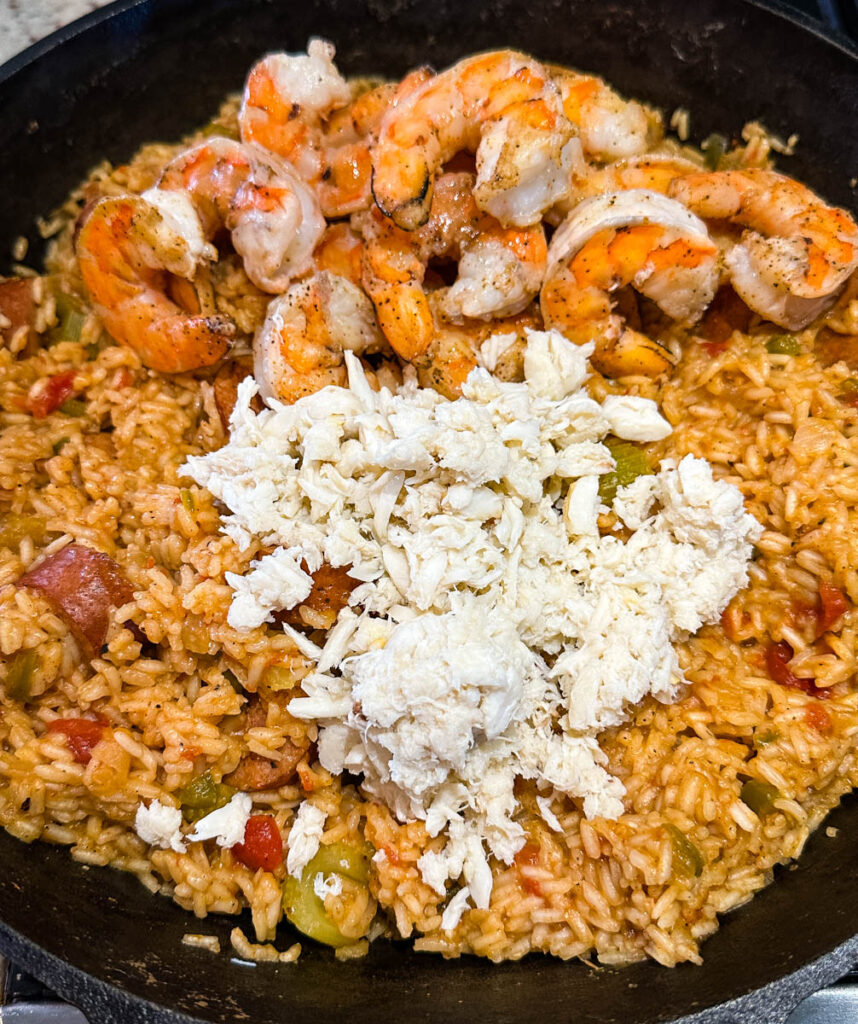
How to Avoid Mushy Jambalaya
In general, a lot of cooking requires patience and practice. If you are a novice cook, or new to cooking a dish like this, your first attempt may require judgment and practice on your end.
Here are some general guidelines:
- Rice Selection: Choose the right type of rice. Long-grain rice has a firm texture and can absorb flavors without becoming mushy.
- Rinse the Rice: Rinse it thoroughly before cooking to remove excess starch. This will help prevent the rice from sticking together and becoming overly soft.
- Sauté Rice First: The recipe below already includes this step. This step helps to coat the rice with oil and spices, creating a protective layer that prevents excessive absorption of moisture and results in a firmer texture.
- Don’t Overcook: Avoid cooking at too high of a temperature, as this can cause the rice to cook too quickly and become mushy. Simmer the jambalaya gently and monitor the cooking time.
- Avoid Over-Stirring: While stirring is important to distribute flavors, avoid over-stirring the jambalaya. Excessive stirring will release starch and cause the rice to become sticky and soft. You want to fold the rice in as opposed to stirring it. This may result in mushy rice. Folding means use a spoon to lift the two mixtures together, and turn them over so they combine.
- Pot Lid: Keep the lid on the pot during most of the cooking time to trap steam and ensure even cooking. Towards the end of the cooking time, you can slightly crack the lid to let some steam escape, which can help prevent excess moisture buildup.
- Liquid Ratio: If you find that your jambalaya is becoming too wet, you can uncover the pot and continue cooking for a few more minutes to help evaporate excess moisture.
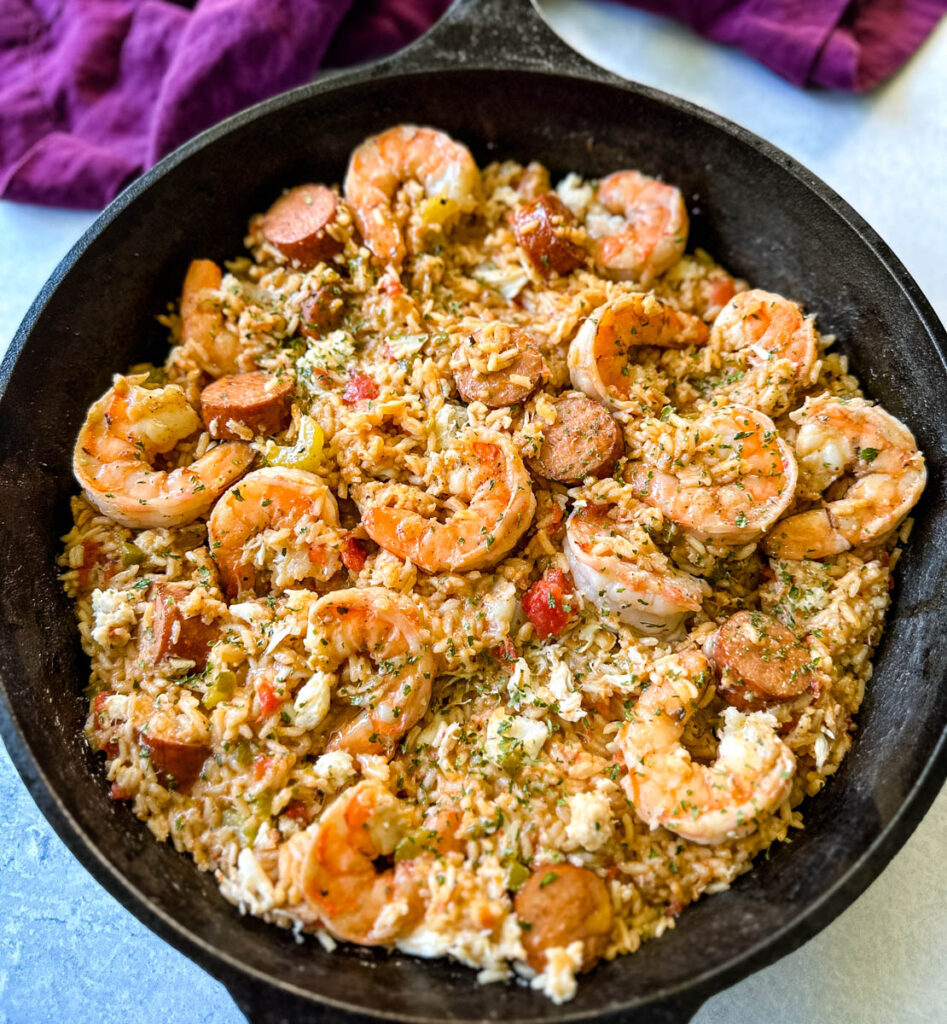
I find the easiest and most foolproof method is to cook the rice separately from the broth mixture. This is a one-pot recipe, so the instructions walk you through how to cook the rice with the broth. But if you’re having trouble mastering the perfect texture, try cooking your rice in accordance with the instructions on the packaging of the rice you purchase.
Instead of adding the uncooked rice to the broth, you will add cooked rice at the end once the broth has simmered and when you add the seafood. Instead of using 4 cups of broth in the recipe, you will only need to use 2 cups since you are adding cooked rice that doesn’t need to be absorbed by the liquid.
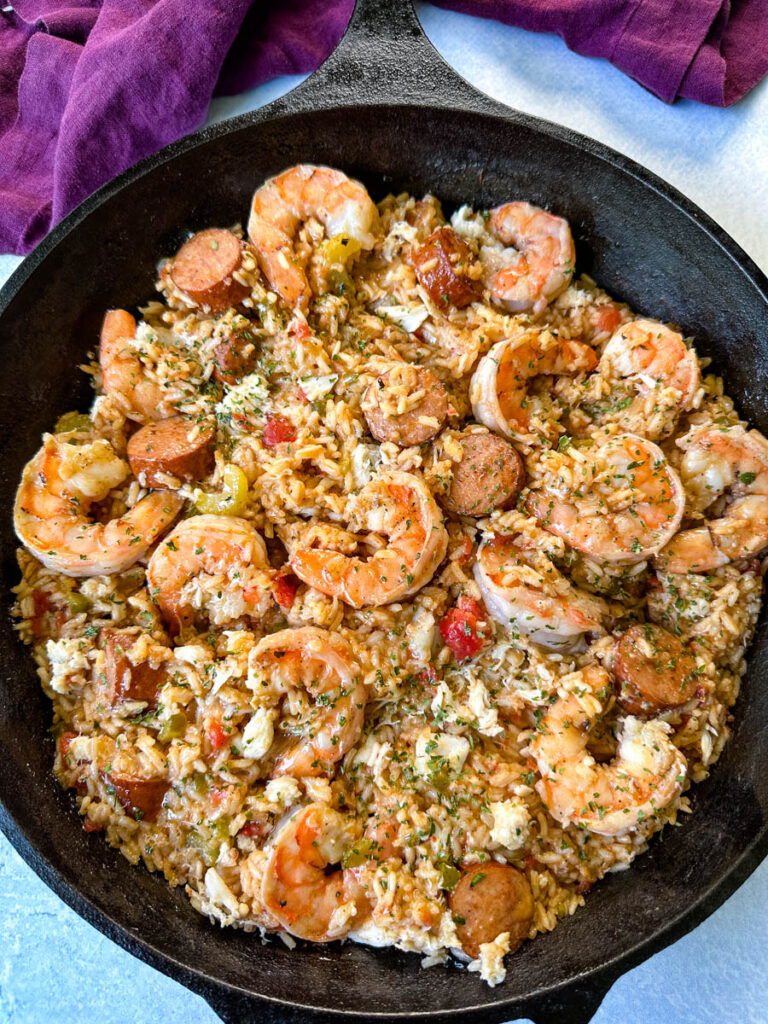
How to Substitute Chicken
Slice skinless chicken breasts into chunks and cook it along with the sausage.
How to Store
Leftovers can be stored tightly covered and sealed for 3-4 days.
How to Reheat
For the stovetop method, add a little broth or water so the dish doesn’t dry out. Reheat on medium-low heat until warm.
If using the microwave, cover the container with a microwave-safe lid. This helps trap moisture and prevent the rice from drying out. Reheat in short intervals.
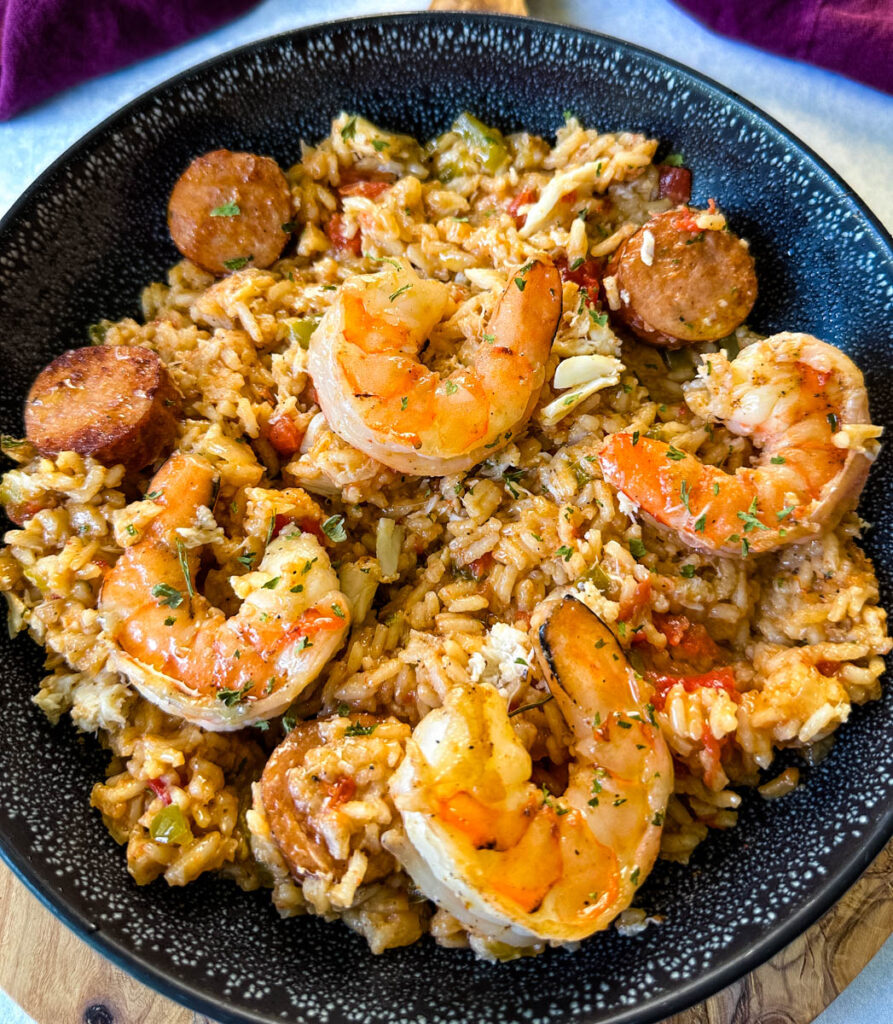
Freezer Tips
You can freeze the dish tightly covered and sealed for 2-3 months. Defrost overnight in the fridge.
Pair With These Recipes
Southern Soul Food Cornbread
Roasted Okra
Air Fryer Garlic Bread
Southern Coleslaw
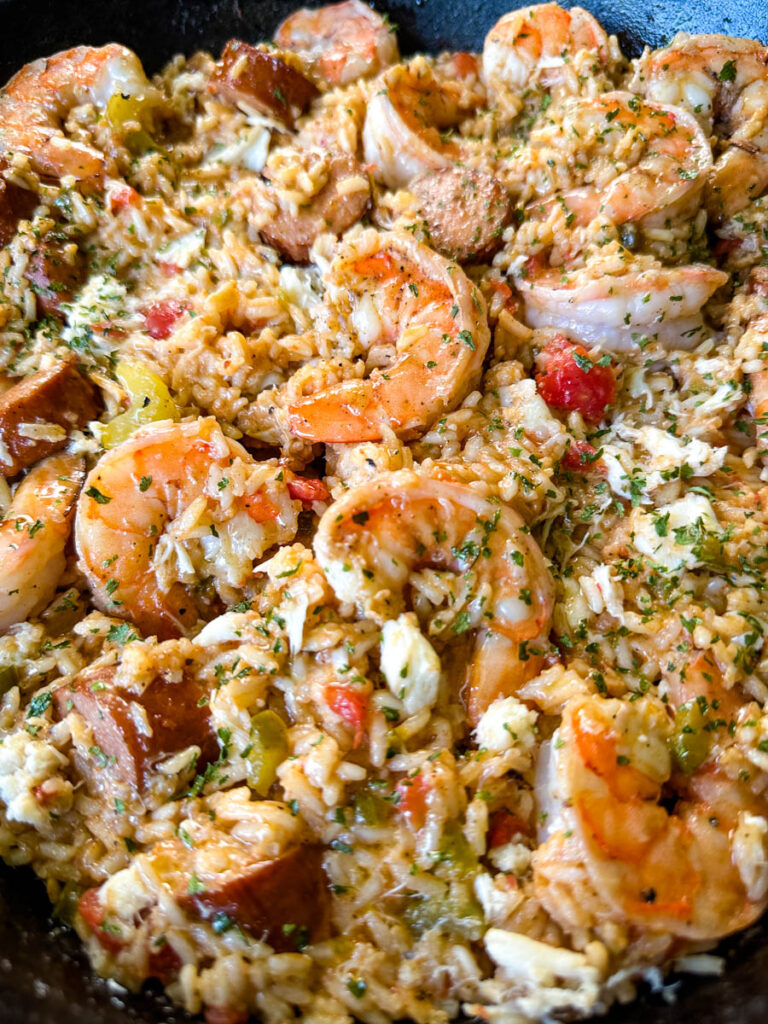
More Cajun and Creole Recipes
Cajun Shrimp Boil
Cajun Shrimp Salad
Cajun Shrimp and Sausage Pasta
Cajun Salmon
Cajun Crawfish Boil
Shrimp Etouffee Recipe
Cajun Dirty Rice
Cajun Seafood Gumbo with Shrimp and Crab
Southern Red Beans and Rice
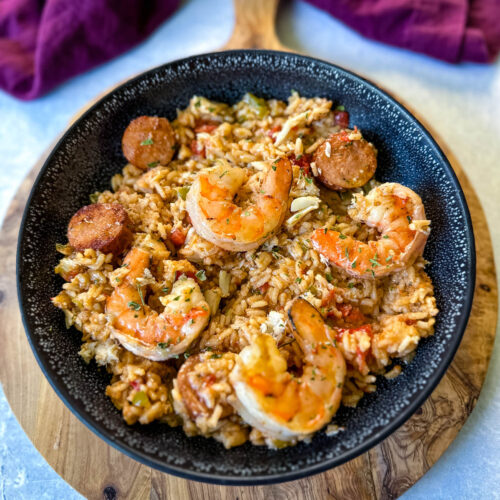
Seafood Jambalaya with Shrimp
Equipment
Ingredients
- 1 pound raw shrimp Peeled and deveined
- 1 1/2 teaspoons Creole Seasoning Divided in 1/2 teaspoon and 1 teaspoon portions; Adjust to suit your taste.
- 1 teaspoon olive oil
- 6 oz andouille sausage Sliced into small pieces. You can substitute ground sausage pork, turkey sausage, etc.
- 1/2 cup chopped green peppers
- 1/2 cup chopped white onions
- 1/2 cup chopped celery
- 2-3 garlic cloves Minced
- 15.5 oz canned diced tomatoes You can also use fresh tomatoes. I use fire roasted.
- 1/4 cup all-purpose flour
- 2 cups long grain white rice Rinsed.
- 4 cups broth or stock Seafood, chicken, vegetable, etc.
- 1 bay leaf
- 1/2 teaspoon smoked paprika
- salt and pepper to taste
- 8 oz lump crab meat Optional
Instructions
- Season the shrimp with 1/2 teaspoon of Creole seasoning and salt and pepper to taste.1 pound raw shrimp
- Add the olive oil to a pan on medium heat. I used a 12 inch cast iron skillet. Add the seasoned shrimp and cook for 3-5 minutes or until it is pink and opaque.1 teaspoon olive oil
- Remove the shrimp from the pan and set aside. Add the sausage to the pan.6 oz andouille sausage
- Cook the sausage for 4-5 minutes or until it has browned. Remove the cooked sausage and set it aside.
- Add in the garlic, green peppers, onions and celery. Stir and cook until the onions and garlic are fragrant.1/2 cup chopped green peppers, 1/2 cup chopped white onions, 1/2 cup chopped celery, 2-3 garlic cloves
- Add in the flour and diced tomatoes. Stir until the mixture is fully coated with flour.15.5 oz canned diced tomatoes, 1/4 cup all-purpose flour
- Add in the rice and stir to toast the rice with the flavors of the pan.2 cups long grain white rice
- Pour in the broth and add the broth and cooked sausage to the pan. Use a wooden or silicone spoon and deglaze the bottom of the pan to scoop up any brown bits on the pan. These bits are loaded with flavor.4 cups broth or stock
- Adjust the heat to boiling and add the bay leaf, 1 teaspoon Creole Seasoning, salt and pepper to taste, and smoked paprika.1/2 teaspoon smoked paprika, 1 bay leaf
- Once the pot reaches a boil, reduce the heat on the stove to low. Cover the pan and simmer. Remove the lid and glide the wooden spoon throughout the pan every 6-8 minutes to ensure the rice doesn't stick to the bottom of the pan.
- Once the broth has been fully absorbed and the rice has softened, remove the lid and remove the bay leaf. This can take 12-20 minutes (or more use your judgment).
- Add the shrimp and crab to the rice. Fold the seafood into the rice. You want to fold the rice in as opposed to stirring it. This may result in mushy rice. Folding means use a spoon to lift the rice and turn it over so it combines the seafood.8 oz lump crab meat
- Cool before serving.
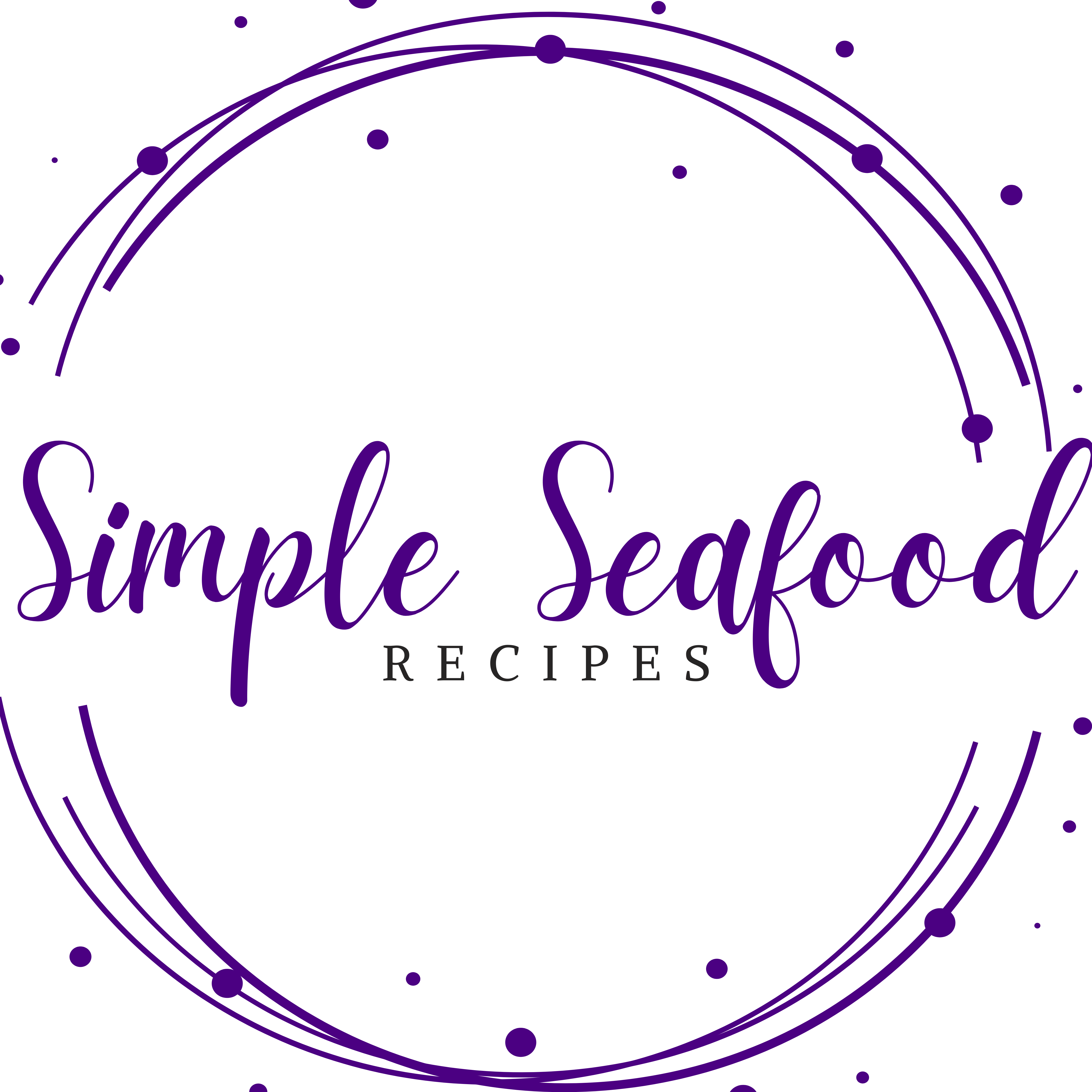
KfnqDuxw
Wednesday 14th of May 2025
1
Ashley
Sunday 20th of August 2023
This is so incredibly delicious! You can’t beat a one pot meal that is full of so many delicious flavors. The lump crab addition was perfect.
Brandi Crawford
Sunday 20th of August 2023
Yay! I’m so glad you tried it!